How to Choose the Right Subscription Technology (or really any technology)
Are you needing to make a substantial technology decision?
Are you ready for your digital transformation and need to identify technologies?
Are you considering replacing your current subscription management or digital systems?
Kathy Sexton, the CEO of Subscription Insider and I provided a webinar this past week to over 300 attendees representing the subscription economy. Check out the webinar on www.subscriptioninsider.com if you want to watch and listen in. Kathy and I will be providing more in-depth webinars in the very near future.
In the meantime, take a few moments and explore the complementary blog series below: “How to Choose the Right Subscription Technology”.
The technology universe grows by the day like our own universe. Ever expanding. We often don’t focus on the parts as much as a singular entity.
It is human to want to find one solution or pattern that fits, does not require change, limits risk and allows us to exist day to day comfortably. Our need in this regard tends to drive our decision making.
We stay away from what we don’t feel is comfortable, we stop listening when one starts using “technical jargon” regardless if it is medical, engineering or technology focused.

Our defenses go up and many want to run the other way.
The result is often a decision based on what others have done, what others have shared or a really good sales pitch that made you feel as if well yeah, I am going to get the shiny new car with all kinds of cool gadgets that solve every need and want I have.
You are made to feel as if anything is possible and that you have nothing to worry about. Until the bill comes or until you start to take things for a “test drive”.
Understanding, identifying and ultimately choosing the right technology for your business is a significant challenge. The ever-expanding Universe of platforms, options, applications, features and functions can indeed make your head spin.
Add acronyms of SAAS, PAAS, IAAS and PCI and sprinkle the following Premises Based, Cloud Based, Open Source, Proprietary and it is even more confusing.
Then worry about how all of the chosen apps, systems platforms and the like will talk to each other and produce the data and information you need. It can be very stressful to say the least.
This blog series seeks to demystify the universe, show some of its parts, bring forward what you need to know, define the jargon and lay out a realistic approach to ensure your technology choices match your unique business needs rationally and reasonably.
Your first requirement is to define who you are, what your goals are and what you are offering in the marketplace.
I cant stress this enough and of course I will do so repeatedly throughout this series. That focus and those answers are critical. Ensure the technology enables, not drives your business decisions, intent and goals.
Know Your Business
Is your business model focused on physical product?
Physical publications?
Digital products?
Digital publications?
Conferences and events?
Subscription boxes?
All of the above or a variety of hybrids, mixes and levels?
Have you managed through a digital transformation of your business model or are you just beginning to consider how you are going to evolve, adapt and position your business for the future?
The above are critical questions to answer and critical classifications to make. The business model, your business intent, your culture, your financial position and abilities all must be considered before you make the leap into considering technology solutions, platforms, applications and the like.
You must think about and understand total cost of ownership (TCO) just like you would think about and understand what it takes to own a home or buy a new car. The “cost” isn’t simply the purchase. It includes maintenance, support, utilities, insurance and so many other items.
The Subscription Technology Universe: The Technology Puzzle
All that said, lets begin to help you understand today’s technological universe or as Kathy and I like to call it the “sub-tech ecosystem” because it is indeed an ecosystem unto itself.
A Subscription Business has very specific needs it has to fulfill. The traditional subscription technology stack reflects a primary need to manage physical products along with people and their subscriptions, collecting recurring payments. The left side of the puzzle represents many systems you have traditionally used and of course still need.
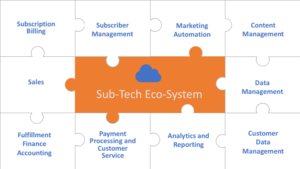
That stack or functionality that ensures the business functions of the stack can occur remains critical. Not all solutions, platforms or applications that you may find easily allow you to execute, meet your needs or what is required to engage and retain the subscriber.
What has changed is the opportunity to consider alternative solutions to meet those needs. Open source, particularly Woo Commerce as an example, continues to expand offerings to include widgets for inventory management, refund processing, warranty provisions and management, connections to the US Post Office for postage and mailing and most importantly widget functionality for subscriptions and memberships.
Fulfillment and its variations remains a critical need and focus of a subscription business and of course you still need to manage your finances, understand your cash flow, enact renewals and respond to customers.
So let’s introduce the puzzle that Kathy and I have put together to reflect at a high level what the sub-tech eco-system now includes.
The New Necessary Technologies
The right side of the puzzle recognizes what is mostly new and being leveraged by subscription businesses. A content management system/platform has become ingrained in the traditional technology stack but functional expectations have changed as businesses recognize the need to do more digitally besides being a “pretty face” on the web.
Content Management System (CMS)
The CMS must now allow a business to create a content machine that uses extensive content organization and description, expands the reach and life of content and which can enable elements of personalization to deepen the digital relationship between you and your subscribers.
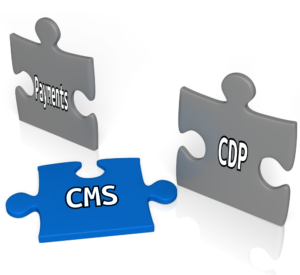 Whether you are product or content focused, you need to maximize the use, reach, findability and discoverability of the products, words and offerings you have in the digital realm. This focus is a must-do, must-have priority that recognizes the urgency required to compete in a digital economy.
Whether you are product or content focused, you need to maximize the use, reach, findability and discoverability of the products, words and offerings you have in the digital realm. This focus is a must-do, must-have priority that recognizes the urgency required to compete in a digital economy.
A quick side note: If you want to learn more about the content machine, visit Subscription Insider’s website for the Content Machine Podcast Series.
Building from the “content management” system, the right side of the puzzle provides you as a business the opportunity to leverage the opportunities in today’s market, match current or prospect customer expectations and compete with existing or new competitors.
Today’s economy is and will continue to be driven by data. Data that transcends known and unknown user behaviors and attributes, consumption of your content, marketing and most importantly sales.
Marketing and Marketing Automation
The Marketing puzzle piece now represents marketing automation platforms and solutions that go beyond email marketing and via which creates a process to enable active delivery and presentation throughout the awareness, consideration and decision process and gives you the immediate insight into what is resonating, how it is performing and how prospects or existing customers are converting to new subscribers or continuing subscribers.
Automation also allows you to segment your audiences, see performance across the segments and be targeted in your approach leveraging who they are, what they do and what offers/content is resonating.
An area that I am very passionate about. If you are a continuing reader, you know I just posted several blog posts on the changing B2B Buyer behaviors, new business models and represented a new view of the customer and buyer focused on Business to Professional.
Analytics
Analytics represents an opportunity to understand how content is performing, how subscribers and prospects move through your digital sites, content and offerings, how subscribers interact and seek customer service, how traffic gets to you and more. Solutions range from simple to complex and costly. Google Analytics is free (you are feeding Google your data of course) while Adobe Analytics or others require a significant license fee. Want to learn more about Analytics for Publishers and Subscription Businesses, see our blog series.
Customer Data Platform (CDP)
The next puzzle piece, tightly integrated with the content management system, marketing automation, your backend systems and more is customer data platform (CDP). This is very different from subscriber management which equates to a CRM/subscriber management focus.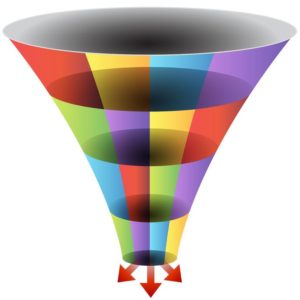
The “CDP” platform seeks, collects and curates your audience data generated by your relationships to your subscribers, the consumption of your content and products, relates the data to demographical or other data in your subscriber management system (or CRM, Sales Platform or other) and gives you an opportunity to analyze your known users to gage resonance and performance. Marketing Automation is a significant source of data fed into a CDP.
The major output and greatest benefit to you from a CDP is intimate and real-time understanding of what is and isn’t resonating with your subscribers or prospects giving you the ability to iterate to improve the desired outcomes.
Another output of a CDP is the ability to leverage the 2-mile depth knowledge of your market and package the data as a product to those in the industry who are interested. It also allows you to create or expand advertising and demonstrate real performance from the ads you may be serving for yourself or others.
Data Management Platform (DMP)
A “data management platform or DMP” is a platform that brings together every or most pieces of data you or others produce and which includes cookies, anonymous user data, third party data and more.
Unlike the more focused outputs of a CDP, a DMP requires you to deeply know and frame what you are seeking to learn from the data, how it needs to be connected and massaged and what programming needs to occur to leverage models and algorithms. As previously stated, a DMP is intended to be all encompassing whereas a CDP is focused specifically on subscribers, prospects and others you would consider customers.
The terms and the functions (and demystifying jargon) need to be correlated to who you are, what you goals are and how you want your business to evolve. Technology is an enabler, it isnt a silver bullet and it should never be perceived as the driver of your business. In contrast, understanding the digital economy and new consumer behaviors is a must as they are indeed the drivers of all of your decision making, not just those related to technology.
What you also need to understand is how your eco-system is supported, hosted and made available to you, your employees and your subscribers.
The Cloud, Open Source and More
A majority of solutions today are “cloud based”. What that translates to in basic terms is the “system, application or platform” is sitting in a data center that you access via a web browser or App based interface. It is not up in the sky floating with the other clouds nor does it have the ability to create rain.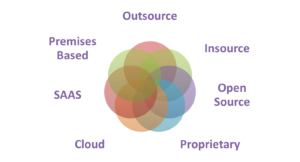
The term cloud also corresponds to a subscription model. Like a subscription product, cloud based services are offered at a monthly or yearly fee that provide you with an instance of the platform, a segment of functionality or access to all functionality including your own partition of a database. Security is also offered.
Cloud solutions remove the need and responsibility for managing servers in the closet, can remove the need for a specific desktop or laptop system, enable mobile access and provide for an upgrade path.
Insourcing and outsourcing relate to whether you want day to day responsibility of managing the eco-system you require with internal technology staff or you use an outsourcing model comprised of those who work within and across the different puzzle pieces on a day to day basis.
As a good portion of subscription businesses are small to medium size businesses, you must decide whether you want this responsibility and if you are ok with taking focus away from other things. All business budgets have limits and priorities need to be determined and set.
Open source or proprietary is your next consideration. If you want to learn more about the pros and cons of open source and proprietary solutions. Take a look a blog post I wrote a while back published both here on the website and on Subscription Insider.
Open source software is curated and expanded by a community. It is in many ways “free” but comes with its own special risks and concerns. An open source solution decision does require you to secure internal or outsourced support for day to day maintenance and monitoring. In that regard, it isn’t free but it can indeed allow you to maximize the community scale and gain new features, functionality and options easily and cheaply.
Open source solutions, by nature, allow easy connection and portability of data exchange and transfer as they are typically newer solutions that don’t carry the baggage of older technology code and structure.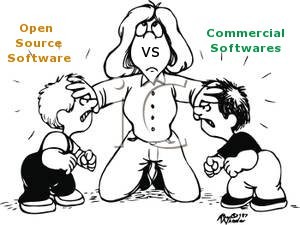
Think relational and connective where older solutions are rigid and hierarchical.
Proprietary solutions are offered by software providers and span premise, app and cloud based solutions. The code base, contrasted to open source, is proprietary and contained and curated, updated and changed by a software company.
Many ERP, CMS and even CRM solutions are proprietary and dominate the market. Again, in contrast to open source, proprietary solution providers maintain a roadmap to expand features and functions that may or may not provide you with what you need when you need it.
Often, the only way for you to get what you need is to pay for “customizations” which may become a bottomless pit and consume a good portion of your available budget. Using a proprietary solution may be a perfect fit but please recognize that you need to evaluate your long-term business goals and ensure a match.
As you “customize”, you surely get the functionality that you need but you are also adding to your long term maintenance effort and cost. Each customization may move you away from the company’s upgrade path.
Each customization may result in being place in your own “partition”. For the company, they like to see you want more and more. The more customized you get, the more money you pay them and the less likely it is that you will be able to change course and select a different solution.

Don’t drink this Kool-Aid
If you do, you are locking yourself into a situation of which it is very hard to get out of.
What should you do? Proprietary solutions can be the perfect match. First and foremost, you need to define who you are, what your business is in current form and what you may aspire to transform into and document your requirements.
Answers to those questions and what is documented can help you evaluate what is and isn’t the right fit for you. Hopefully you recognize my emphasis on needing those answers first and foremost.
Coming Up Next
In the next post, I will bring forward some specific examples from the puzzle, relate some of our client’s experiences and provide some of the initial “how-to” framework you can use as you prepare for a new “technology” purchase.
The third post in this series will bring together all of the questions you should be asking, what process you should follow, what documents you need and finally some rules for you to follow.
Want to watch or listen in to the Subscription Insider webinar? Learn More on the Subscription Insider Website.
As always, we are here to help you on your digital, marketing and technology path. Contact Us Today.



